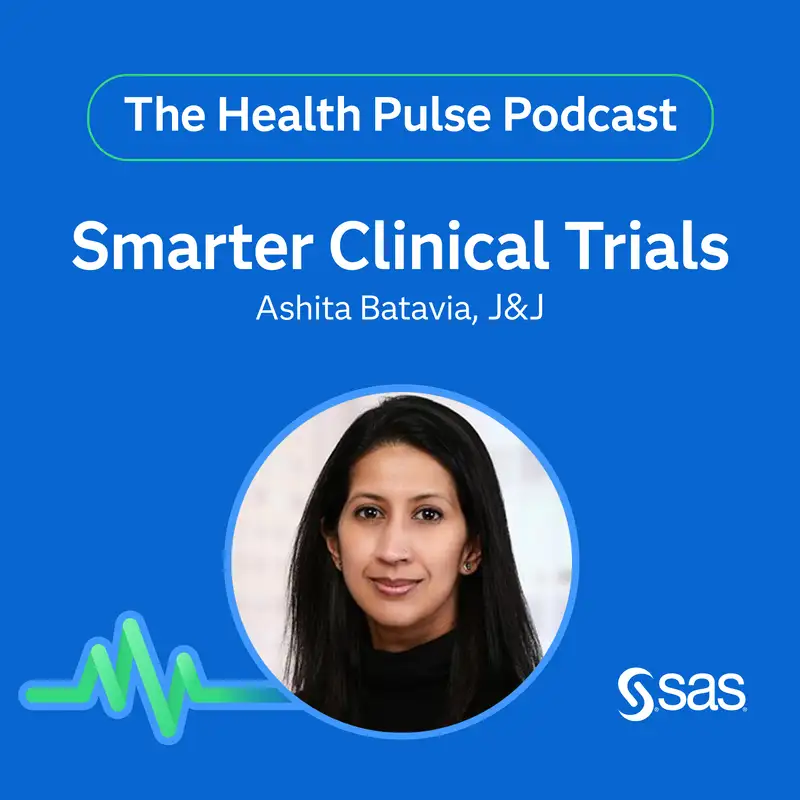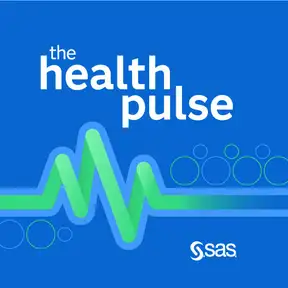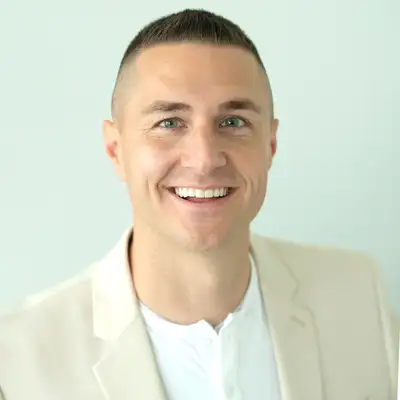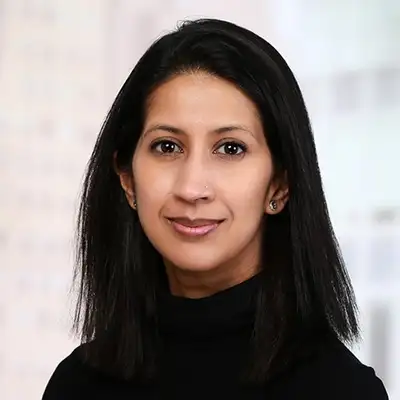Harnessing the power of data to advance clinical research
ASHITA BATAVIA: We all want the same thing. We want better, safer treatments for patients. That's the bottom line. And figuring out how to do that together, independent of externalities and environment, that is still, unchanged, our North Star. And I think we're making progress in that direction.
ALEX MAIERSPERGER: Today, you'll hear from Ashita Batavia, Head of Hematology and Data Science at Johnson & Johnson. She has an uncanny ability to get people to adopt technology in pursuit of the North Star in life sciences.
[MUSIC PLAYING]
Ashita, you've always had a hand in multiple worlds-- clinical as an attending physician, research on funded grants, as a principal investigator, and then on the academic side as a publisher. So you have that wide-view lens of the world. Ultimately, in all of those places, you're looking at the data that you have.
We hear a lot of fit-for-purpose data. And so data that can be used in that clinical setting or in the academic setting and the research. Can you walk me through your viewpoint from a data lens of what we have and maybe what we need?
ASHITA BATAVIA: That's a great question. I would say that it usually starts, Alex, with the question. So what are we trying to answer? And so there may be a question around a efficacy signal for a treatment in a population that is somewhat different from what we studied in the trial.
So for example, in a trial, we may exclude patients with non-perfect kidney function. But then, when you get to the real world, and you have a patient with the disease and their kidney function isn't qualifying for the trial but this still appears to be a strong treatment, what is that going to look like for that patient? How do we give them information?
So those sorts of questions we try to answer with real-world data. Now, if we were to try and take a cohort of patients from the real world and understand, these are patients that have received this treatment, what is the efficacy like, then we'd want to certain pieces of information to help us line up those patients with the ones in the trial.
I'm going into a lot of details, but essentially, the example I wanted to give was performance status, kidney function, things like that, you have to have all of those data points. If it's not populated, can you use that patient? Can you not? So you design a study that really centers on answering the question that you have, and that tells you what exactly are the fields that you really need to have in your data set in order to be able to do the analysis.
And I think that sometimes there are challenges because fields that may be critical for the purposes of the research question may or may not exist or be populated consistently in the real-world data, which limits your ability to draw that insight to the level of robustness that you would want.
ALEX MAIERSPERGER: I like the hope that one day we have data sets that we get to ask every question to and we get to have all the answers. But in the real world that you talk of, we have to live in the real world, and we have to have data and patience.
You talked about the clinical trial space already. There's always been a patient and physician awareness challenge. So just knowing that there are trials out there going on for a specific disease, specific health challenge. And then you obviously have to go into the recruitment, retention, collection, which has other challenges.
You said real-world evidence. There's been an explosion of wearables, sensors, tracking devices, new technologies like GenAI. Hybrid external control arms are gaining more acceptance. And so we're getting into what feels like a little more of the future is coming faster for clinical trials. Have you already experienced that they've changed significantly?
ASHITA BATAVIA: I think there's elements of trials that are more ripe for change and taking advantage of some of the technological progress that we're seeing in this moment, but by and large, trials still need to do the basics, which are collect rich data, have clear information and conclusions that can be drawn about the efficacy and the safety of the product, and that part never changes.
I think there's perhaps some thoughtfulness against the, What are we collecting? How are we collecting it? that can be used to streamline a little bit. So an example of this. We had a Nature paper last year where we took an H&E out. So let me back up a second.
So when you have a tumor, you can cut off a piece of the tissue, a piece of the tumor, and look at it under a microscope. And you look at it on a slide. That's an H&E slide or a pathology slide. It's a very basic stain. And we built an algorithm that could look at that picture and predict presence or absence of a qualifying mutation for our trial.
Totally orthogonal insight. No pathologist on the planet can look at this image and tell you that information. The data science, the computer vision, the algorithm is just so sophisticated relative to what was possible before. And so that's a totally novel insight that you can use to say, hey, I have a patient who might be a good fit for this trial, but I have to go do the confirmatory molecular testing.
That still happens. We're not replacing it. But here, within a few minutes, we could tell you, hey, the odds are this patient may not be a good fit for this trial, I don't think it's going to come back, rather than waiting a few weeks to see the results.
You can do that. That's patient and physician choice. But if you want to take into consideration this thing works, maybe you want to start the conversation about what your next option would be. Because as a person who's had family members with cancer, that waiting-to-see period is a non-trivial emotional experience, and being able to give that intel to patients faster matters.
Another potential application of that could be, we have a site where we're running a trial, and it's available, but it relies a little bit on serendipity. The physician has to know that the patient is going to be one that could match up with the trial that's happening at their site. Physicians-- not a secret-- very busy running between patients and appointments. And everything is really rushed.
So you can forgive that they may not make that connection point in the moment. They can come back to it later. But here, if you have the appropriate permissions and security pieces in place, you could see a world where we could run that algorithm on the background, and then if it looks like it's a fit, push a reminder to the physician and say, hey, this patient of yours might be worth thinking about in context of this trial. Just an idea.
And it's on the-- you're not taking away decision rights. You're not making decisions for patients or physicians, but you're creating an avenue to streamline and bring it to the front of their mind. And that can be helpful for accelerating trials.
And other things that people talk about a lot are pragmatic design elements for trials. And this is another really interesting area where it's not quite the sexy AI applications or the advanced analytics. It's something much more simplified, where we collect a ton of information for our trials, and not all of that information is need to have. A lot of it is nice to have.
And so that nice to have creates some additional burden for patients, potentially for providers. And so if we go back and we look carefully at all of the elements we're collecting, is there a way to reduce certain elements a little bit without impacting our understanding of efficacy or safety? Is there something we could do around making sure the schedule of visits lines up with what the patient was going to do normally for their routine care?
Maybe you're not calling them back in for an extra visit, because that can be quite a lot to ask of individuals who have busy lives and so forth. So there's just many different levers for meeting patients where they are and meeting providers where they are, and making sure that we're thinking holistically about this trial experience in a way that gives us answers and is still gracious to the realities of every person who's participating.
ALEX MAIERSPERGER: We're really not that far removed from a surgery without anesthesia or from antibiotics and the discovery of some of these things. The way that you talked about how now a cancer outcome can largely depend on serendipity in some cases, it just makes me think that in the future, we're going to look back on this time of medicine as still very primitive.
I think you painted a very pretty picture of the combination of people and technology to be able to gain insights faster than a human could alone is really exciting to hear the future of targeting specific diseases and being able to lessen that time of not knowing what's going on and what can be done about it.
You also talked about tech-enabled collection, and you mentioned both on the patient side and the physician side. And so it's probably an improvement on the life of both of those stakeholders in care. Are there parts of the process between the clinical care delivery and that research side that can be automated or improved?
ASHITA BATAVIA: I think so. I think we had a really great white paper with Friends of Cancer Research towards the end of last year, where we were talking about pragmatic trial designs. And one of the ways that we do this is streamlining criteria, streamlining what we collect, this PRECIS-2 wheel.
But what we did in the white paper, which was really interesting, is we went further. We said that another avenue for streamlining is to allow technology to help you find patients. So what do we mean by that? I gave you the example with the algorithm for bladder cancer, that H&E algorithm.
Another far less tech-exciting kind of approach to it is if you look at inclusion/exclusion criteria for a trial. It tells you, we want patients with this disease, this age, these comorbidities, this functional status, all of these things. A lot of those things that we have listed in the inclusion/exclusion, they are in structured fields in the EHR.
So you can almost build an algorithm in the EHR that generates flags and says, hey, these are patients that are coming in this week that are meeting some of these criteria that when you see them, it's worth a conversation and, as the provider, to think about this some more. And maybe this person could be a fit.
Maybe they could, maybe they couldn't. But this kind of offering you up a first pass of who might make sense to approach is a really powerful way of trying to streamline trials and how we're thinking about who to enroll and who's the right person to enroll.
Another thing is, we use the electronic health record a lot for patient care, and there is a lot of duplicative entry into electronic data capture systems for research. Is there a way to streamline across these two different systems so you don't have somebody at the site manually re-entering the same pieces of information?
That seems like it's a really straightforward thing to solve. It's actually like devil's in the details, kind of complicated, but those are the types of things where these smaller innovations pave the way for bigger innovations. And I hope we're going to get there in a question coming along later.
But one of the things-- we talk a lot about analytics. And we have these great analytic capabilities today. One of the things that could further unlock use of all these great analytics is great data. And great data that's multimodal data, where we're able to look at omics data, clinical data, imaging data, pathology data, outcomes data, all of it together. If we could put that data into a usable format with usable standards, the analytics can really, I think, start to unlock more value.
ALEX MAIERSPERGER: I love how you brought it back to the basics of, you're a physician. You have five patients coming up this afternoon. Here's what to talk to them about. Here are the things that they might qualify for. I think those are the things that profoundly change our industry.
And so like you said, it may not make the press release, but spread amongst different organizations and around the country and around the world, those are the things that really make a difference in the lives of both the patients and the physicians and care teams who are providing for them. So really love that you brought that back.
You've made it to the speed round. So we're going to get to know you a little bit, maybe outside of work life, and get to hear some of your preferences. So we're starting with, what's the favorite app you have on your phone?
ASHITA BATAVIA: I am a compulsive news reader, so I'm always on the Times, the Washington Post, or the Wall Street Journal when I have a few minutes. And then if it's not that, it's my Kindle app. So I like to read.
ALEX MAIERSPERGER: Is there a news aggregator for that that you use, or do you subscribe to multiple apps for your clicking through?
ASHITA BATAVIA: I have an aggregator too, but I still like going to the main app for those. I think I realized through this question that I'm probably much weirder and more of a Luddite than I'd like to admit.
ALEX MAIERSPERGER: Are you a morning or a night person?
ASHITA BATAVIA: A morning person. Yeah.
ALEX MAIERSPERGER: How about mountain or beach?
ASHITA BATAVIA: Oh, beach. That's easy.
ALEX MAIERSPERGER: Oh, your kids are morning people, so you have to be.
ASHITA BATAVIA: Yeah.
ALEX MAIERSPERGER: Makes sense. Mountain or beach?
ASHITA BATAVIA: Definitely beach.
ALEX MAIERSPERGER: What's next on your travel bucket list?
ASHITA BATAVIA: On my bucket list, I really want to go to Senegal. I've never been to Senegal, so that's on my travel bucket list, right next to Morocco. But I don't know that we've got that planned any time this year.
ALEX MAIERSPERGER: Your favorite form of exercise, which pairs well with the next question?
ASHITA BATAVIA: I love swimming.
ALEX MAIERSPERGER: All right. So the important one that is the crowd favorite is, what's your favorite ice cream flavor?
ASHITA BATAVIA: Oh, chocolate chip cookie dough.
ALEX MAIERSPERGER: Oh, that's right near and dear to my heart.
ASHITA BATAVIA: That is the--
ALEX MAIERSPERGER: Cookie dough is--
ASHITA BATAVIA: Cookie dough ice cream. There's just-- you can't get better than that.
ALEX MAIERSPERGER: But now that there are so many edible cookie doughs, I've sort of taken the ice cream out of the equation and just gone straight for the cookie dough.
ASHITA BATAVIA: I could respect that. Do you put it in the freezer and just have it cold? Or is it room temperature and you really just abandoned the ice cream.
ALEX MAIERSPERGER: Yes to any of the way that you could phrase that question of how I eat cookie dough.
ASHITA BATAVIA: Yeah.
ALEX MAIERSPERGER: Oh. Actually, one scoop of vanilla ice cream with a cookie that is only warmed up so that it's essentially warm cookie dough is the thing that I think everyone needs to try once in life. Or every Friday, if we're being honest.
ASHITA BATAVIA: Before or after the exercise happens? Ideally after.
ALEX MAIERSPERGER: Yeah, I think it depends on how far you swim, I think, how much you reward yourself.
ASHITA BATAVIA: [LAUGHS] Fair.
ALEX MAIERSPERGER: I think there's probably quite a few listeners out there hearing even the foundations of AI and the foundations of new technology and how things are changing, and they're saying, I can barely get my spreadsheet to open and to work. There's that large maturity curve for data science capabilities across organizations.
Are there any commonalities that you've found or things that you would want to share to help others on this journey? When they hear that bright, shiny, fun press release that says, AI is helping diagnose this exact tumor down to the individual cell and this is amazing, and they're saying, I don't even know where to start on that and we're so far away from that here, how do you help someone along that maturity curve?
ASHITA BATAVIA: I think that it really would come down to defining what your ambition is and your timeline, and really picking a few great use cases, because I think, in any organization, I'm going to guess there's going to be a few people that really believe that this is the future and want to charge towards that vision, and then there's going to be others that feel like they're doing OK right now, and does that really need to be the direction of travel?
And in order to be successful as an organization, you need to bring everybody along. And the way that I've seen people feel motivated and brought into the conversation is to work with them to, first, identify and define a use case. Pick one. Start somewhere. And then, with that use case, see how you can best execute it with the advanced analytics or multimodal data or whatever it is that makes sense for that use case and clock a win.
Once you have a win and somebody can feel like they understand it, they're going to be more open-eared for the next use case and the next use case. And I think, depending on where you are in the maturity journey, you can either look to leapfrog. You can look to slowly build towards the subset of use cases that are going to be the most valuable for you. It doesn't mean everything needs to be up level to AI and GenAI, but maybe there's a stream of things that you can align on.
Or if you're already one of the front runners in the space, which, I mean, I'm extremely biased, but I think J&J is a front runner in this space, for us, it's a matter of just staying on top of what all of the innovations are and being really thoughtful about how they align against what our business needs and priorities are.
And we do a really good job of scanning, finding, and having the humility to say, you know what? Maybe you don't need an advanced analytics approach for this one. I think this one might not be best suited for it. And that kind of also is, interestingly, a trust building exercise when you're talking to others within the organization, because you don't want to be the person with a hammer who's looking around and only seeing nails, right?
ALEX MAIERSPERGER: That's really incredibly wise advice and just strategic to be able to say, even if there are some maybe naysayers or people that feel like we've got enough in our organization, to be able to sit back and say, what are the exact outcomes we want, and where are the areas we want to invest in these type of technologies and these capabilities to get those early wins is really so crucial. That was really great how you laid that out.
We talked a lot about some of the exciting things in the world, the way clinical trials are changing, the way data is changing, the way it's getting easier for patients and physicians to automate some of the things that used to be cumbersome in the collection process. There's obviously some not-so-fun things to talk about in the world of health care and life sciences as well of just micro and macroeconomic challenges and global supply chain fears, and all of the things that we can so easily talk about-- cost, quality, and access, both to drugs and to care. Over the next 12 months, what are you-- despite all of these challenges and headwinds, what are you excited about?
ASHITA BATAVIA: I think I'm excited about the fact that people are talking about GenAI, people are talking about technology, and there's a curiosity. And as soon as there's curiosity, there's an opportunity to educate, learn, and push things forward. And I think that's like-- to go back to the last question where you said, OK, there are those individuals that are a little bit more hesitant about technology and everything else, can I tell you, one of the most satisfying things is when you convince one of those individuals.
And you know what, generally speaking, they're probably extraordinarily smart people who just have seen a lot of success with doing it a certain way for so long. When you can show them the value and bring them into the conversation and get them excited and curious about how to keep building on the current state of technology, those are really, really meaningful. And those are the ones where I kind of feel like I'm floating a little higher in my chair on days like that.
So I think that to me is hope over the next 12 months, is we have so many different challenges. And there is so much new technology, so much interest in data and trying to figure out how to best align it to-- we all want the same thing. We want better, safer treatments for patients. That's the bottom line.
And figuring out how to do that together, independent of externalities and environment, that is still, unchanged, our North Star. And I think we're making progress in that direction. And that, to me, is worth being excited about for the next 12 months, next five years, who knows.
ALEX MAIERSPERGER: I saw the excitement come out. I also saw the competitive streak come out of, we gotta prove some people wrong, which I think we're all glad that we've got you fighting for patients everywhere. Ashita, thank you so much for being on The Health Pulse podcast.
ASHITA BATAVIA: Thanks for having me.
ALEX MAIERSPERGER: Thanks for listening. If you know a wrong way to eat cookie dough, or if you'd like to be a guest on The Health Pulse podcast, please email us, thehealthpulsepodcast@sas.com. See you next time.
[MUSIC PLAYING]
Should I say, thanks for being here, or something, or just welcome? Oh, maybe. She has an uncanny ability to get people to invest. Ugh.
ASHITA BATAVIA: What's your favorite, beach or mountain? You didn't answer.
ALEX MAIERSPERGER: I know. I refuse to be on the opposite side of podcasts. I get to ask the questions.
Creators and Guests



